How To Clean Up Bad Topology Blender
You just sculpted a new character concept, retopologized it, and added an armature…but then you move a os and realize that your topology just doesn't work as you'd hoped it would. Organic, stretching surfaces such as skin require carefully crafted topology that deforms well in a broad range of poses. Accounting for this variability is non an easy task, especially if y'all're not skilled in animation or used to working with characters.
So, with this in mind, I've prepared a few tips from my ain experiences of modeling for animation. With some practice, your topology may be able to work merely too when animated every bit it does when in a T-pose.
Marshal Faces with the Axis of Rotation
First upwards, face alignment. Adjustment edge loops to the centrality of blitheness tin prevent faces from distorting and causing unwanted shading artifacts by ensuring that faces stay apartment, fifty-fifty in farthermost poses. In near cases, your topology will naturally align to the axis of animation. For case, an elbow volition naturally have edge loops that flow in the same centrality as movement. Just paying special attending to how your loops flow tin can help in some tricky situations.
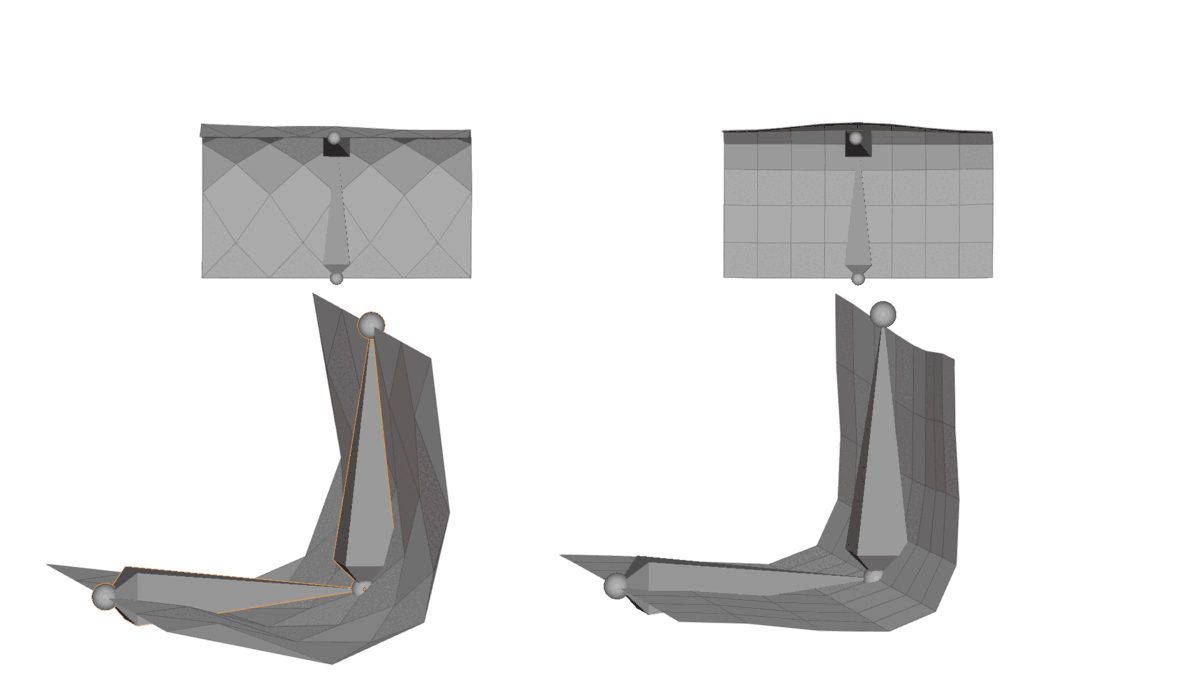
Notice how the faces become non-planar (flat) when they are deformed against the flow of the edge loops. At render, these faces are split into triangles that create an odd ribbed pattern countering the animator'southward intent.
Keeping faces flat is the basis of why topology is important in the starting time identify. This is why good topology in-game models is less vital (triangles are most e'er flat!), and using northward-gons ion modeling can be problematic. The more points you have to work with on a face up, the more probable it is that you volition have a non-planar surface.
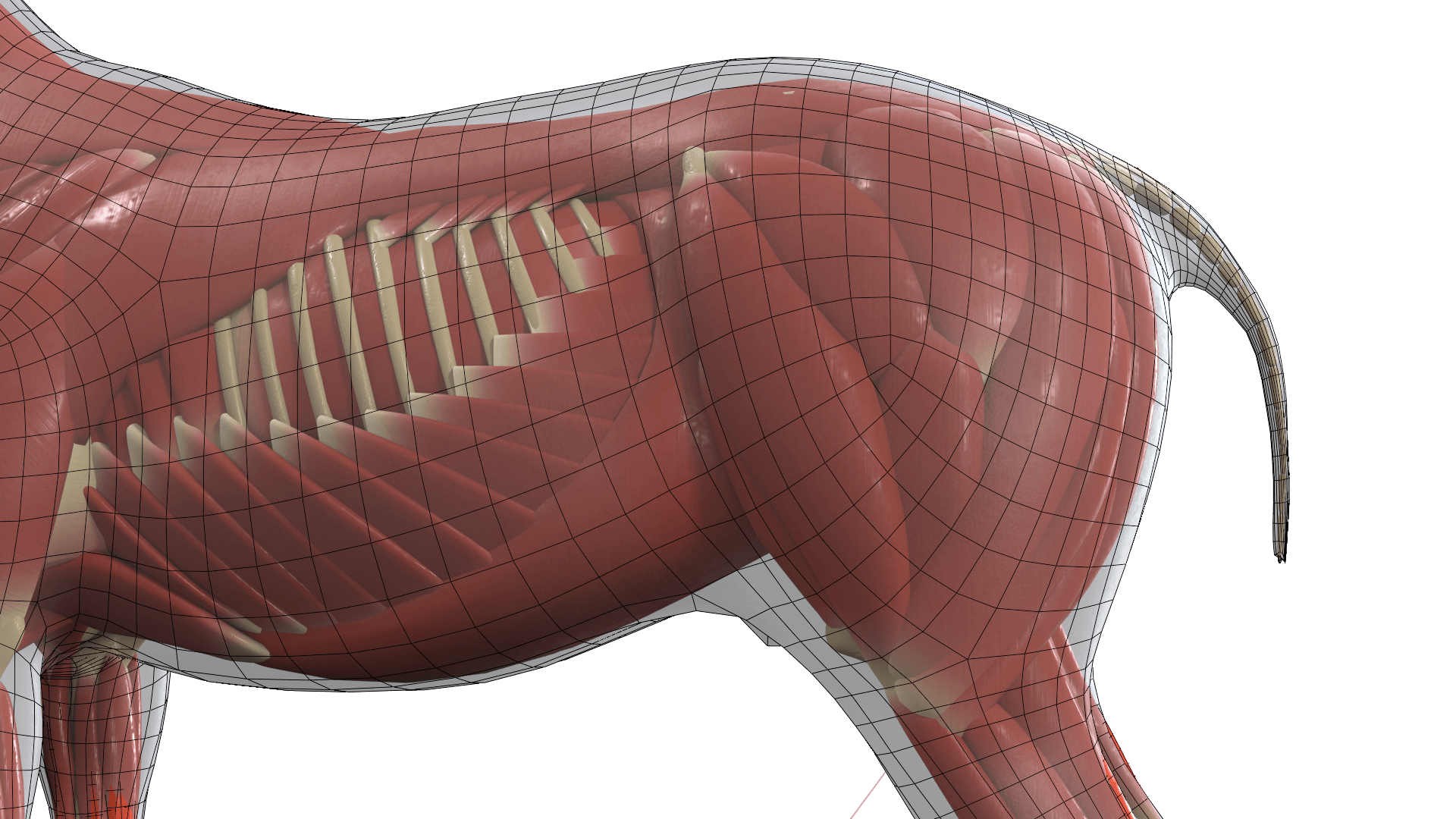
Some other tip for organic models is to follow the muscle structures of the deformation betoken you lot are modeling. If your topology roughly matches the underlying musculus structure, in virtually cases, the animated model will push and pull vertices forth the same axis of the muscles.
Move Problems To Reduce Artifacts
Even the best models have areas that don't deform well. Sometimes, the key to solving these issues isn't eliminating them only moving them. For instance, v+ border poles cannot be completely eliminated from a complex model, but moving them can help significantly reduce the problems poles cause. By the mode, you tin can read more well-nigh moving edge poles in our article "Moving and Manipulating Border Poles"
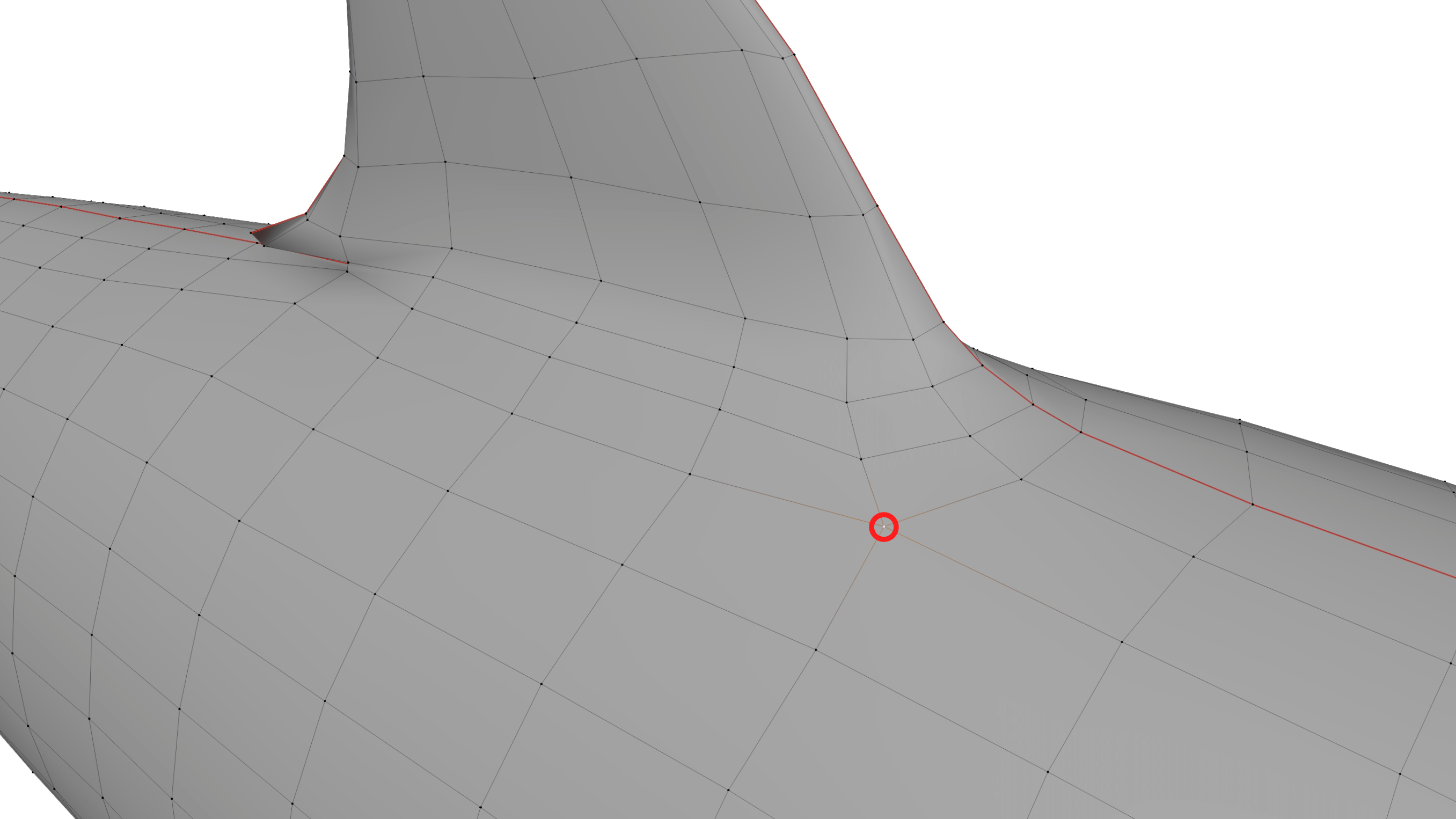
Moving problem topology to areas with less deformation can make issues irrelevant in applied use. Moving an n-gon to a flat surface of your model tin can get in practically invisible in your final animation. See above how the edge pole is not in the corner of the shark fin? Instead of placing the pole where it naturally would be, the pole is moved out towards a neutral position where information technology volition not interfere with the move of the fin.
Extend Loops around the Insertion Point
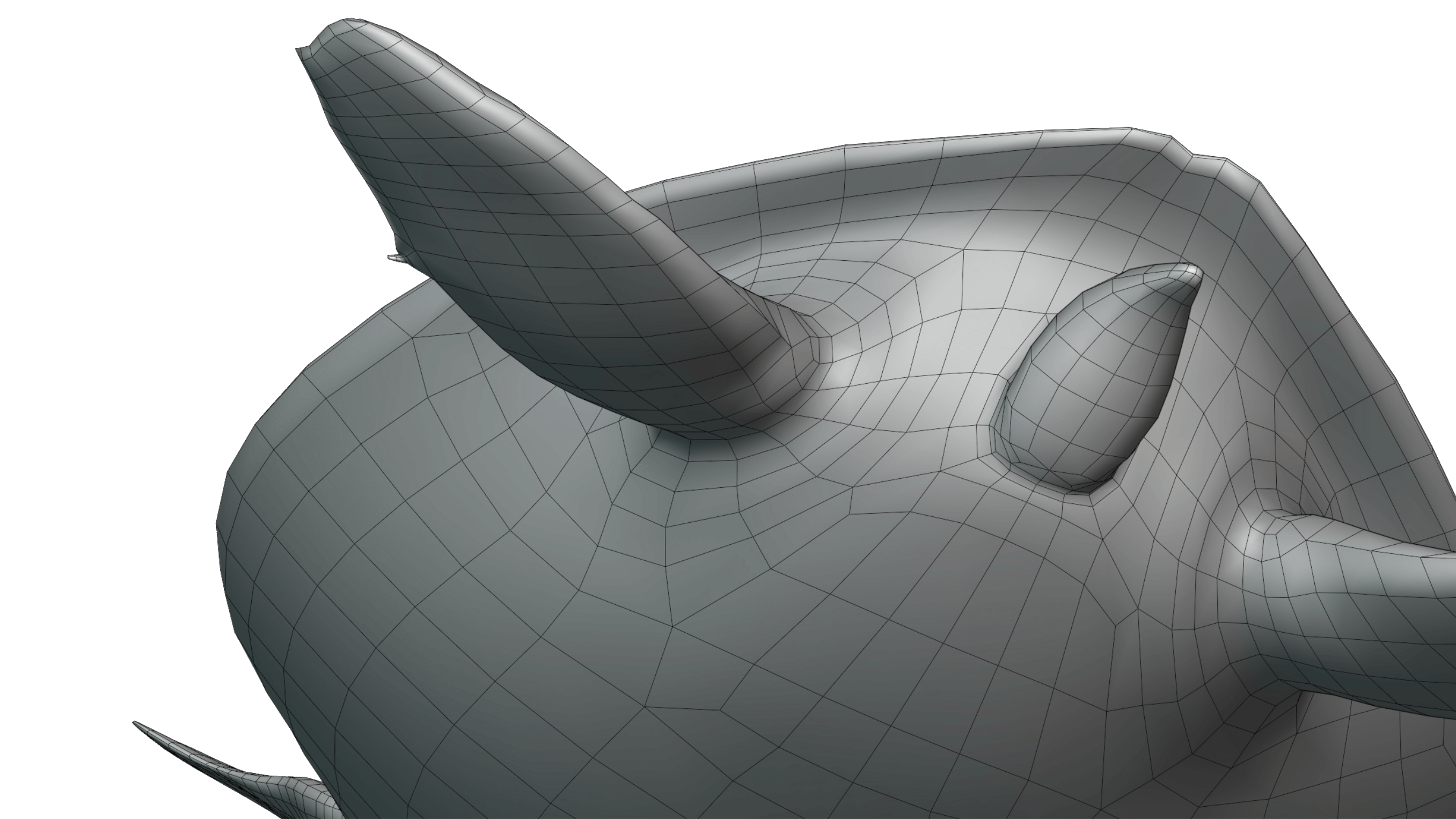
Using extra edge loops in areas with heavy deformation is the easiest manner to prepare your model for rigging/blitheness. In transition areas and musculus insertion points, extending loops past the deformation area into the flat surface of your model can let joints to deform more naturally and exist much easier to weight in rigging. In the case above, the turtle's fin can now rotate to extreme angles without issues because of the extra loops. Pairing this with moving poles towards flat surfaces can solve many deformation bug.
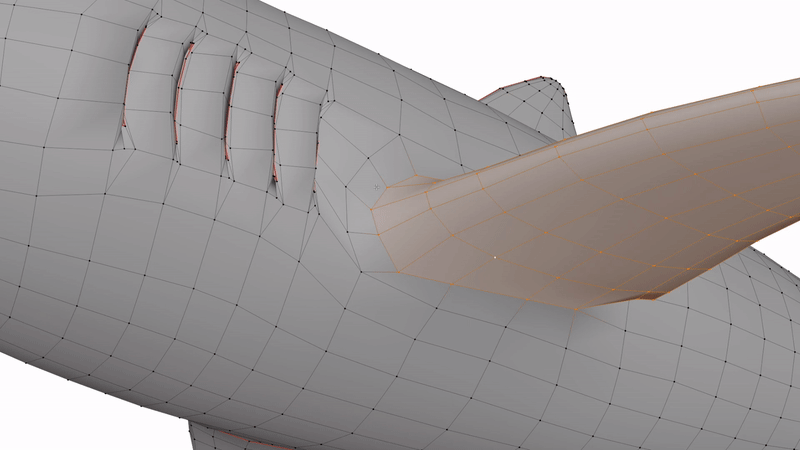
In Blender, you can hands create actress loops around the insertion point of a deformation point by using the outset tool. Select a face up loop and press "I" so "O" to create a ring of faces outside the selected faces.
Friction match Density with Movement Areas
If polygon counts are an issue, modeling deforming areas of your model (e.thou., a character model's face) with a higher density than non-deforming areas tin can help to reduce polygon counts without sacrificing good topology. For example, using edge loop reduction techniques, you can add together density to your model's key features and terminate edge loops before less central areas. While modeling with even mesh density can be a virtue, varying mesh density tin can be a lifesaver when working on heavy models.
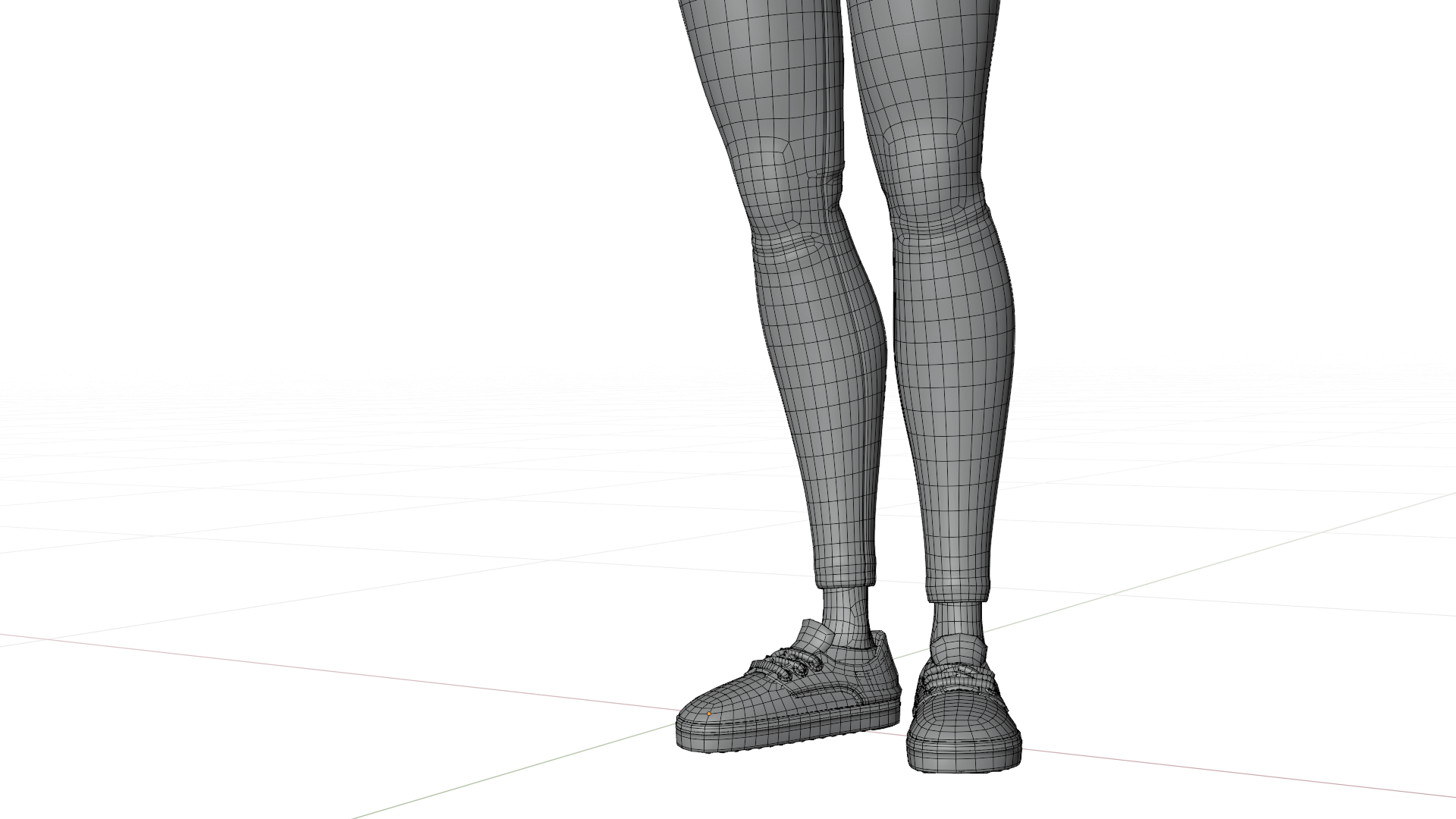
Look how the density higher up increases in the knee and talocrural joint. This ensures that when the leg bends, there isn't excessive stretching or artifacting.
Have any tips of your own? Leave them in the comments below! Also, If you enjoyed this post, please consider supporting the site on Patreon to help pay for some of the costs of running the website!
Go a Patron!
Today we're going to take a look at a very common modeling task modeling hands. Hands are one of the almost complex shapes on the human body to model. An arm is ane affair, but some other five appendages? Topology and mesh density can quickly leave of hand (pun intended). Furthermore, animated prepare hands must be ready to deform in virtually whatsoever shape while still looking skillful.
So without further ranting, here'southward a couple tips for modeling your next hand. Once you accomplish the bottom, yous tin likewise download the final mitt with loop flow notes using the Sketchfab link.
Reference…Reference….Reference!
Organic forms, peculiarly those we're most familiar with, require acute attending to reference. Information technology's easy to take every bit granted that we know what a homo mitt looks similar, only in one case you begin modeling, information technology's easy to assume forms and end up in the uncanny valley. Even when working with base meshes, reference is a necessity. Base of operations meshes are all near recognizing the major forms of a model, that means paying attention to muscle and bone structure is just as important at this step as it is for sculpting or texturing.
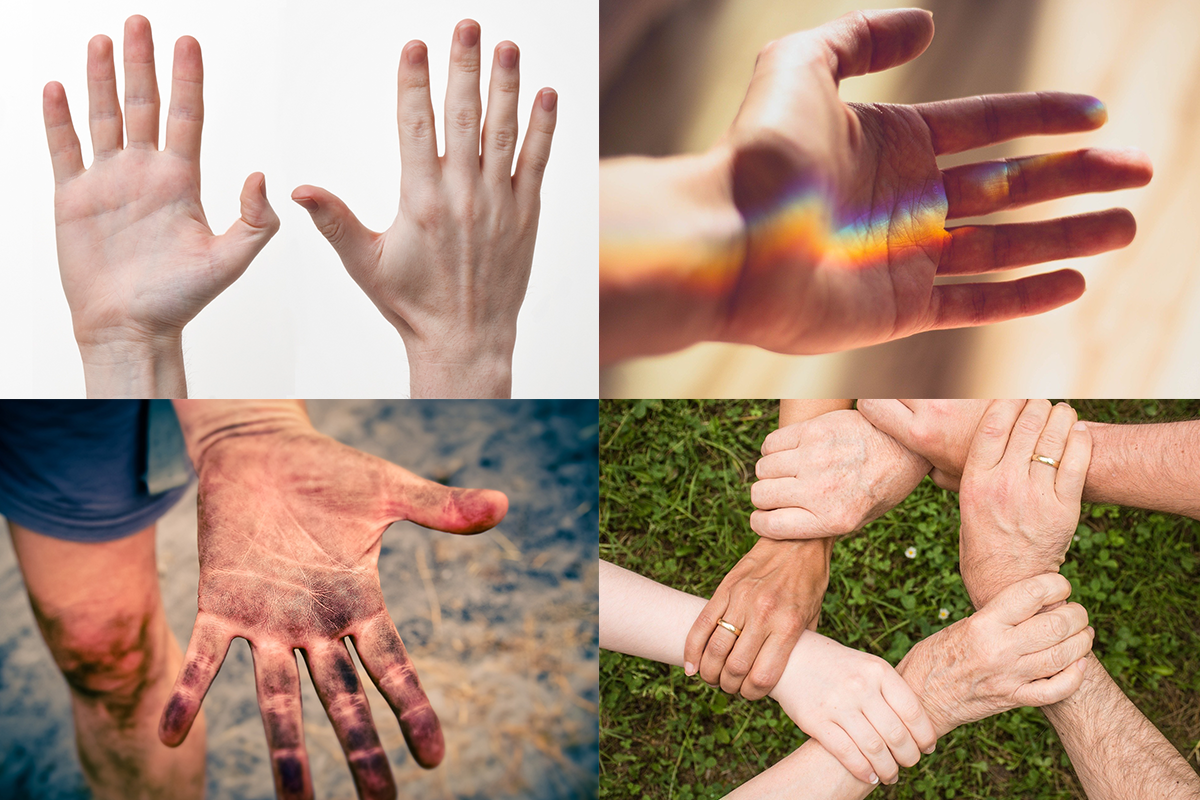
For example, while working on this post, I initially modeled the back of the hand with inset loops almost the duke, only after looking at my own hand, I realized that it would exist more accurate to accept the loops extend downwards across the mitt because the whole surface area deforms in certain positions.
TLDR: Check your reference…and and then check it once more.
Place Primary Loops
The human being hand has a lot of primary loop locations. This is why it'due south a safe bet to kickoff identifying these earlier you build out much of the model. A bully mode to do this is past using the grease pencil tool over your reference image. Marker out anywhere that should accept make clean loops of edges. For example, the wrist, fingers, knuckles, and thumb pad. Marking these will help you avoid redoing work correcting border loops that menstruum in the wrong ways.
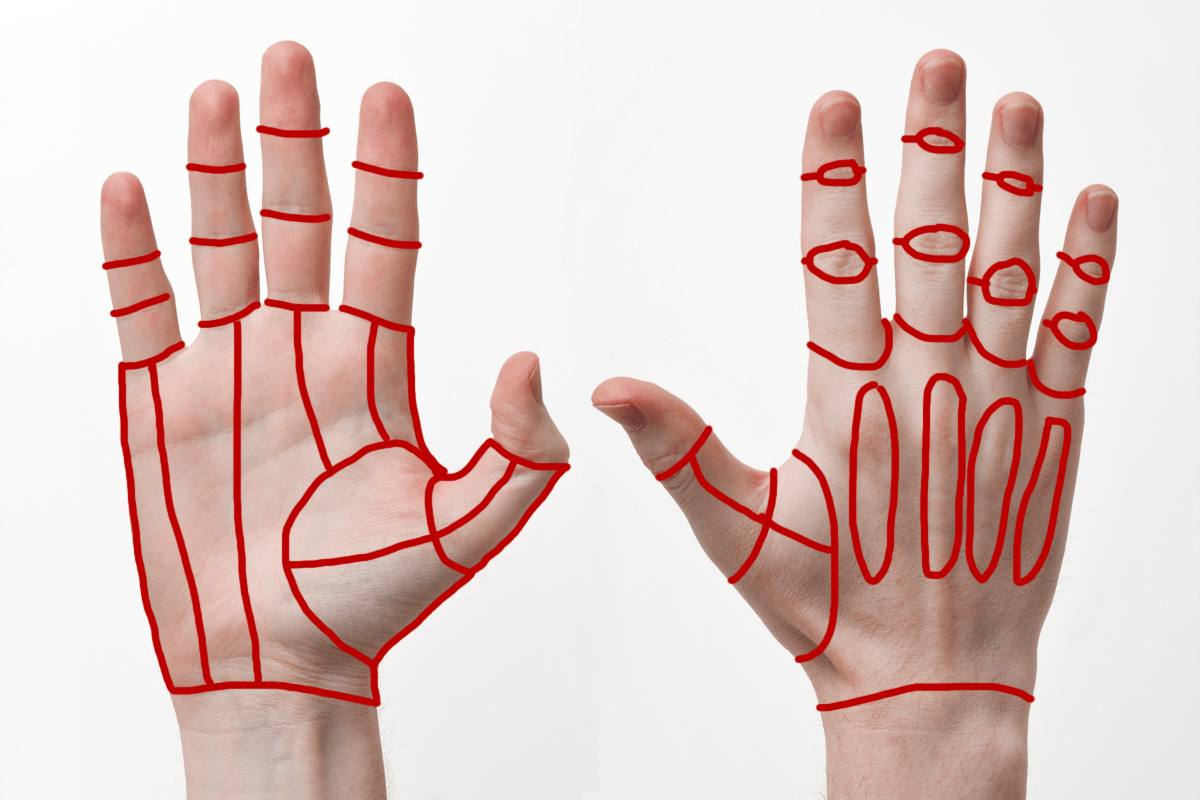
One time you've marked your principal loops build them out using geometry. You can automate this using something similar Retopoflow. Remember to check your border count in loops. Each finger should accept the same number of loops. Sticking to multiple of 4 for loops is besides general good practice. Pay special attention to the loop count of the wrist; 16 is more often than not plenty and volition be at least shut to the loop count of whatever arm you adhere.
Exercise the Like shooting fish in a barrel Stuff First
Next, use the loops yous made to make full in the areas between them. If you see a problem coming at a loop transition, leave it and work on filling as much clean topology as you tin can. If y'all work too much to make a skillful transition area, only to demand to fix it over again, modeling can get frustrating very quickly. You'll likely see most problems at the base of the thumb and between the fingers.
Fix Tricky Loop Transitions
At present you should have enough topology to know what your transition points need to exist like. Now your topology skills really come into play. There is no prepare all solution to transition points, but these principles are practiced guides: Commencement, check your loop flows. The easiest way to get in a mess is linking ane end of a loop to the wrong point on the opposite end. Second, learn loop reduction flows. These will be essential to catastrophe flows then yous don't end upwards with dozens of edge loops at the wrist. And Lastly, persevere. Sometimes y'all merely gotta keep trying new things until information technology works. Don't be afraid to delete topology.
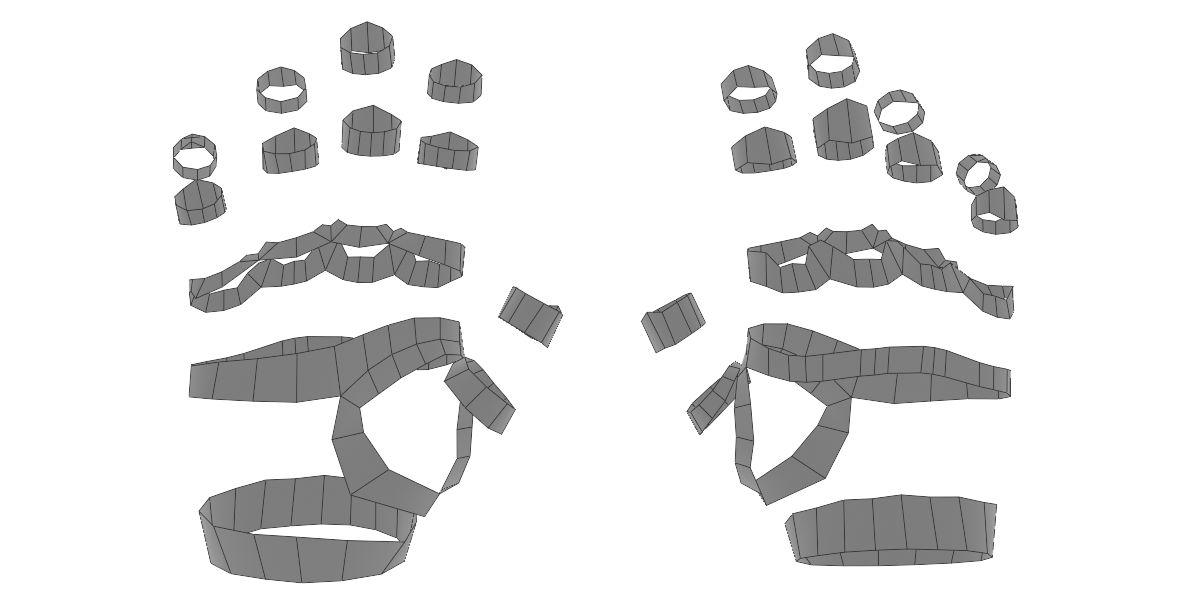
Make Your Rig Happy
Terminal, but not least, add together deformation areas and brand your rig (or rigger) happy. Deformation areas (marked in blue) help topology stretch properly in extreme positions. The all-time way to add these areas is to offset a grouping of faces by pressing I then O and adding a pocket-size loop effectually the area that needs extra geometry. More often than not, the tops of joints demand the most extra geometry. in some cases, it tin can be easier to add more loops instead, but this can besides create actress to geometry to compress inside the articulation.
Below you tin come across the final result and the main edge menstruum highlighted. You tin also download the model from Sketchfab here.
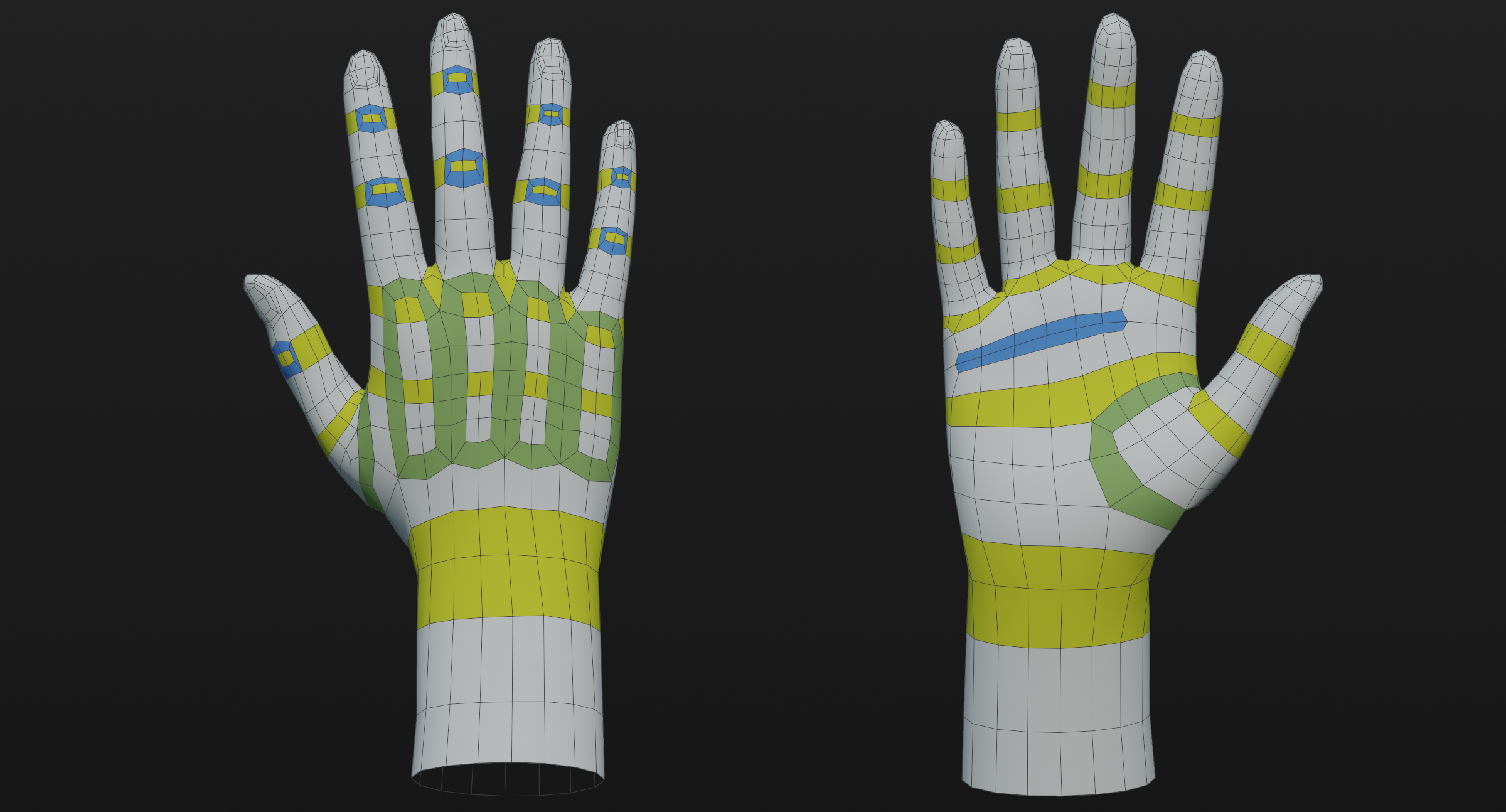
If yous enjoyed this post, please consider supporting the site on Patreon help pay for website costs and give me motivation to keep writing guides!
Become a Patron!
For some models, creating bevels is a simple equally adding a bevel modifer. Only for other models, more complex methods are needed. One of these methods is creating transitions betwixt ii bevel widths. Exist it a auto dashboard or a piece of furniture, bevel transitions are everywhere. This brusque guide volition show you lot the almost optimal ways to create transitions between bevel widths.
Method #one - Quick & Dirty
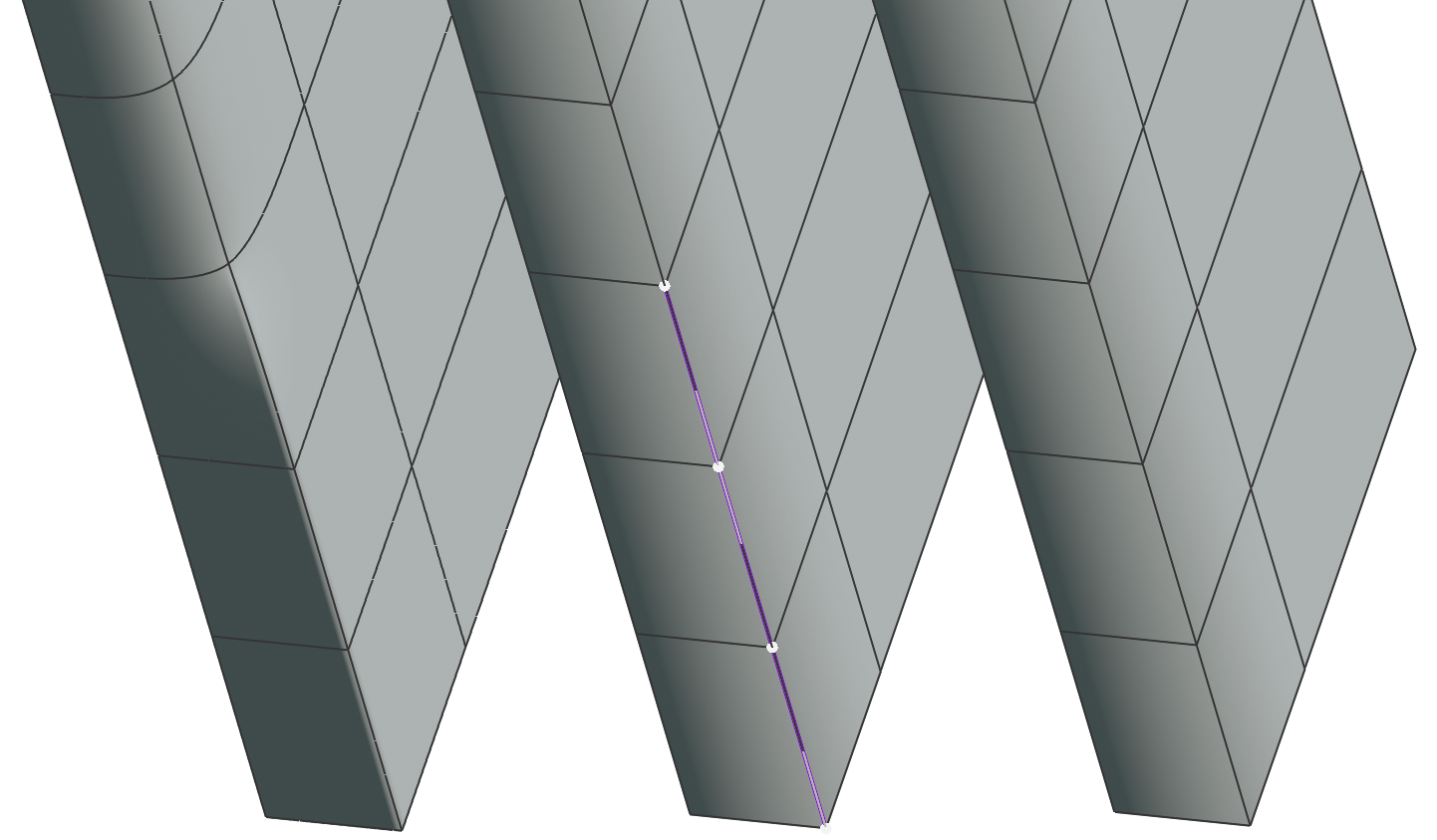
First, the quick and dirty method. If you're in a compression or if you lot're modeling something that's unlikely to be viewed close up, this is the method to utilize. This method involves using edge ceases to sharpen at variable levels. In this case, the sharp border has a crease of i.00 and the wider bevel has a crease of 0.00. To adjust the crease of an border in Blender, employ SHIFT-E.
Method #ii - Smooth Bevels
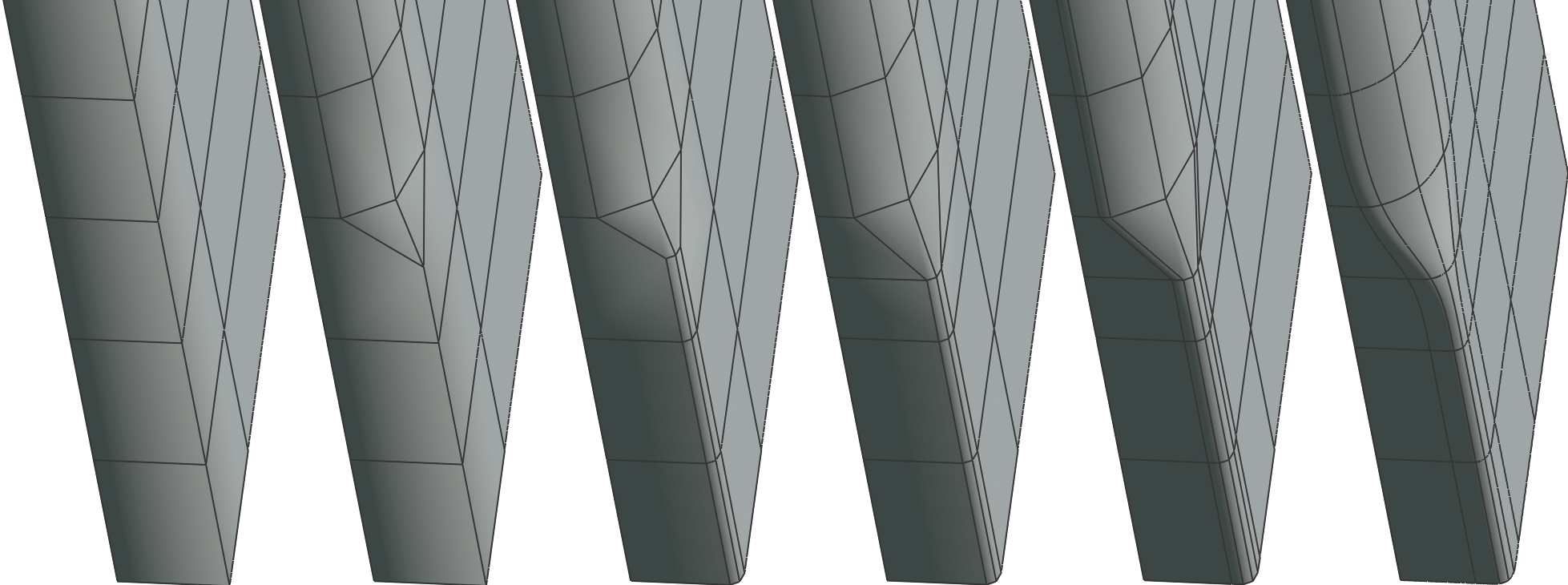
This method is a bit more circuitous and involves using the bevel tool (CTRL-B) to separately bevel each bevel width and then combining the ii bevels by cleaning up the merge betoken in pace three. This method also using property edges instead of edge creasing to take more command over the bevel profile.
Using this type of transition is perfect for of import bevel transitions and high-poly modeling where model density is less restricted.
Method #3 - Sharp Bevels

This terminal method is for abrupt chamfered bevels. Using creases and single segment bevels, information technology's piece of cake to create very clean transition points. The important step here is to merge the extra vertices in pace four to restore the edge flow.
That concludes this cursory intro to variable bevels! If this guide was useful to you, and then please consider sharing it or contributing to the project's Patreon page.
Go a Patron!
Let'south talk virtually Edge poles, those famously aggravating little points on a mesh that cause and then many headaches for 3d artists effectually the world. Why are they so terrible? What tin can we do about them? And when are they really skillful to utilize?

Edge poles are generally considered to vertices with more or less than 4 connecting vertices. On a polygon mesh, this ways vertices with either 3 connecting edges or 5 or more connecting edges. Poles most ordinarily form when triangles or n-gons appearing in models, hence why such polygon types are more often than not avoided in 3d modeling. Triangulated meshes (such as game models, or photogrammetry models) are most notably known for consisting about entirely of edge poles with very few 4-border vertices, the same applies to meshes with large numbers of n-gons.
The Problem of Poles
And so y'all might be wondering, why do border poles get such a bad wrap? The primary reason is that an border pole creates pinching around its perimeter when subdivisions or smoothing is applied. This is why a cylinder with a triangle cap looks and so odd when applying subdivision surface smoothing. The example below shows why this tin can be a problem on curved surfaces. The cantankerous-department view shows that the corner that contains a pole volition yield an uneven surface when subdivisions are practical.
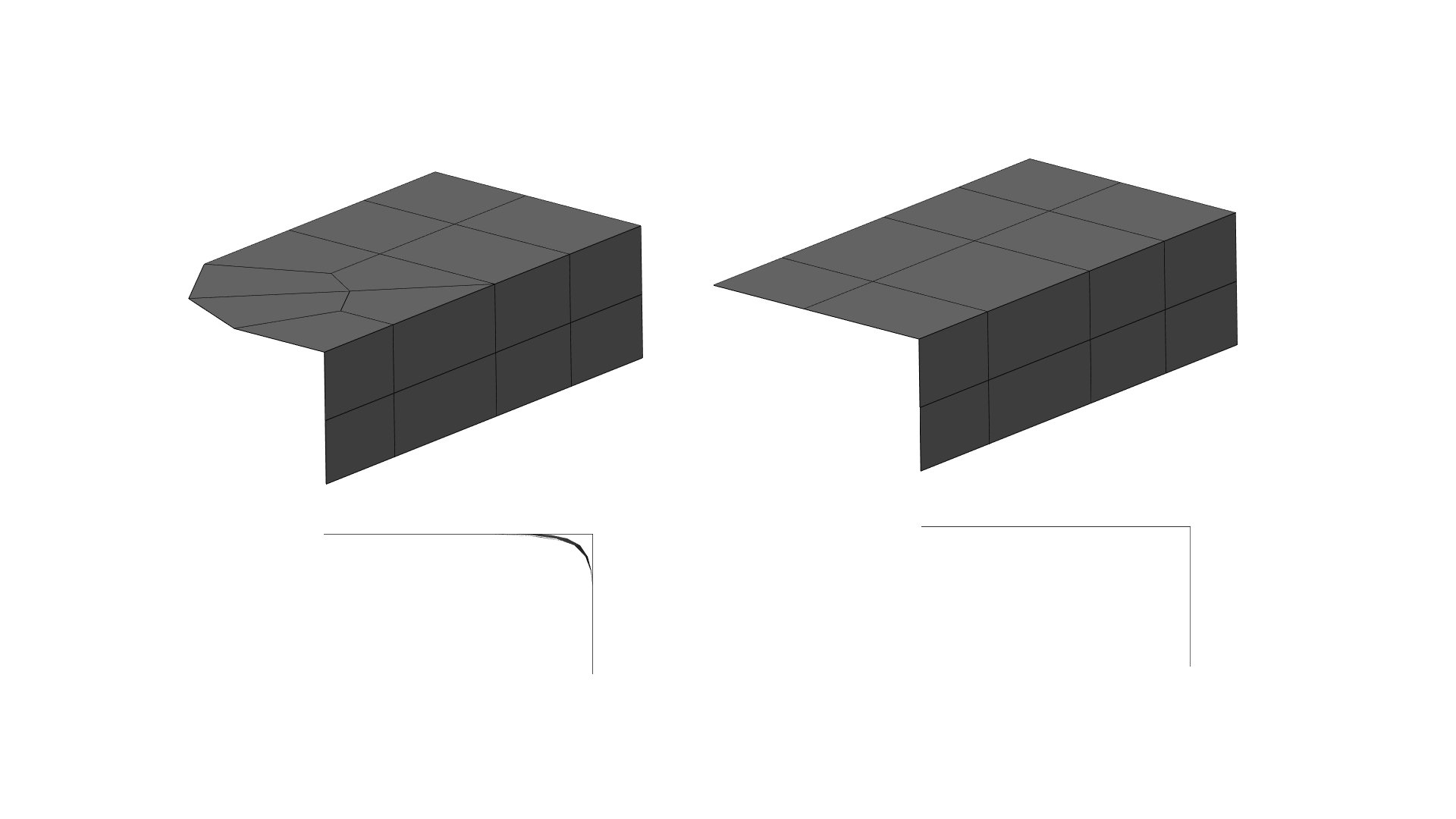
Despite the pinching created by poles, they are an important function of modeling and a necessary component for many modeling techniques and shapes. And then this the balance of this mail service will endeavor to explicate a bit more well-nigh poles and how to use them finer.
E-poles
East-poles are the near mutual pole type and consist of 5 edges intersecting at a unmarried vertex. E-poles are virtually notorious for appearing when extruding faces on a mesh and for forming unwanted flat "corners" within the topology when edge loops meet or turn. E-poles are also what form concave corners in hard surface models.

Due north-poles
N-poles are vertices that consist of 3 intersecting edges. This type of pole is far less common, but often appearing around poles or inset parts of a mesh. In organic modeling, this pole is often known as the "nose" pole, since N-poles are oftentimes necessary for modeling the base of the nose. Due north-poles are also what class the corner of a cube or most other convex corners.
Other Pole Types
Poles with six or more edges are generally considered to be bad do and almost never show upwardly in good topology. Again, on flat surfaces, vi+ edge poles can be acceptable if absolutely needed, but this is a rare case.
When are Poles Ok?
Yous've probably come to realize that poles are inevitable, and required for proper topology. But when exactly do we know when a pole should or shouldn't be where it is? It all comes downwards to curvature. If a pole is changing the curvature of the surface, so it should be removed or eliminated. This unremarkably happens on corners or whatever other areas of extreme curvature. Of flat surfaces, less visible areas, or areas with a slight curvature like a cheek of a face are areas where poles are least destructive and are where y'all should try to place or move poles to.
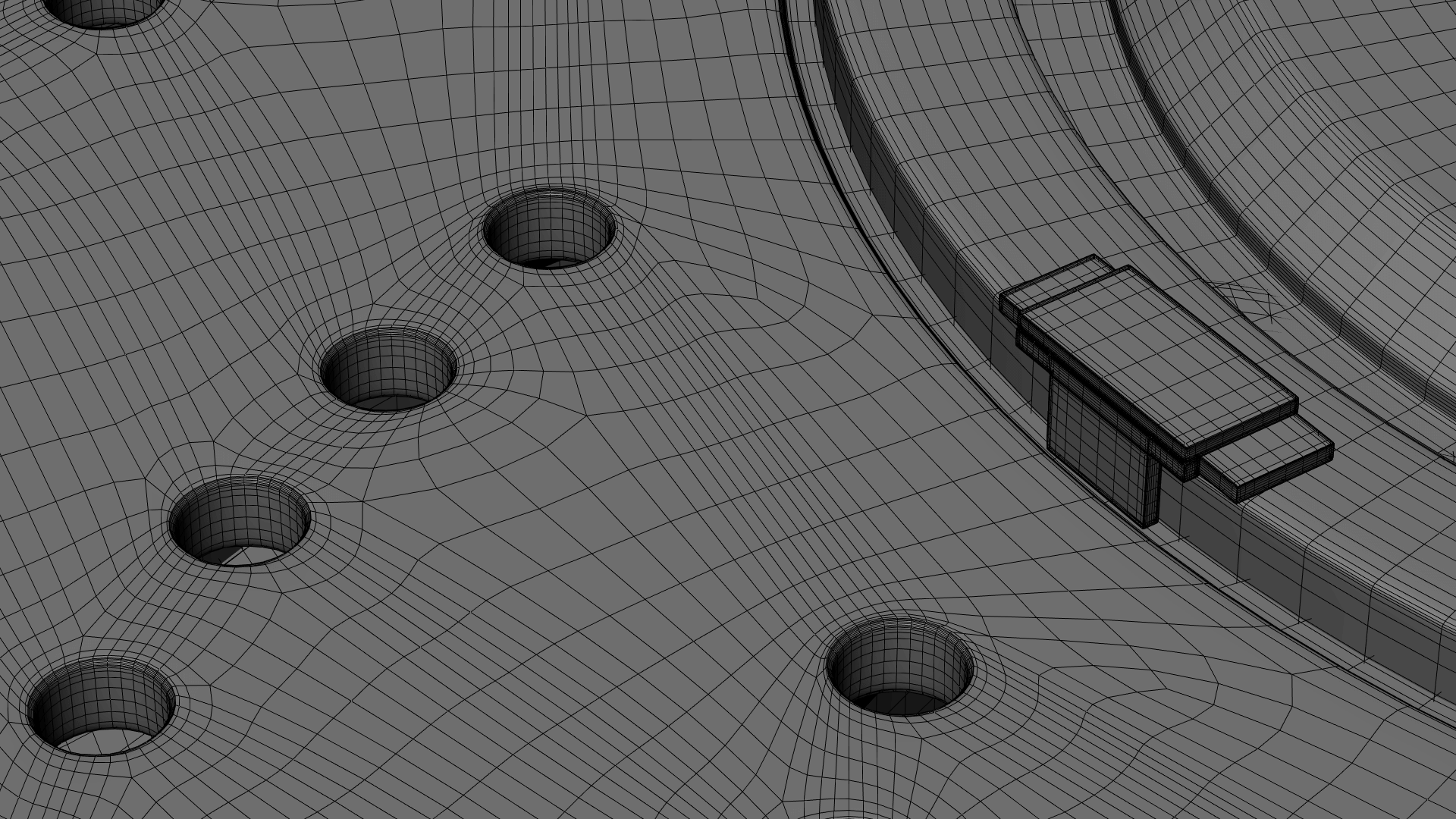
Moving Poles: The Keen Compromise
1 of the most requested topics I've received is how to move poles. And for good reason, poles tin be very difficult to move without modifying topology in an agin way. In almost every circumstance model density must exist changed to accommodate a alter in pole locations, causing the topology to quickly become very sloppy if multiple edges need to be moved. This is why the best advice for moving poles is to not movement them wherever possible by planning your pole locations is advance. It's pretty easy to judge where a pole volition grade by looking at the major flows of a surface and where they intersect. That intersection is where a pole will appear. Luckily, it'south upwardly to you where that intersection happens.
But, in the case that you do terminate upward with a pole that needs to exist moved, there are a number of options for moving poles depending on your needs. Every situation requires a slightly different approach, however, there are some general techniques for 3 and five-border poles that can be a skilful basis for moving a pole. Something to remember, whenever a pole is moved, one edge loop must be removed in the direction the pole is being moved, while another is subtracted from wherever the pole came from. The reason for this is that the edge loops must exist redirected around the new location of the pole. Otherwise, an n-gon volition announced.
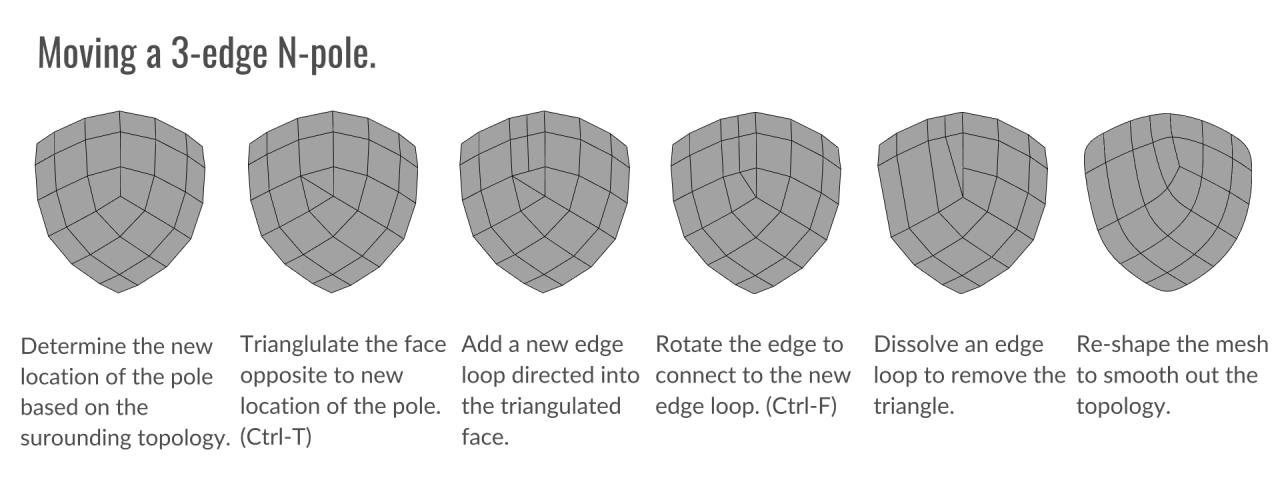
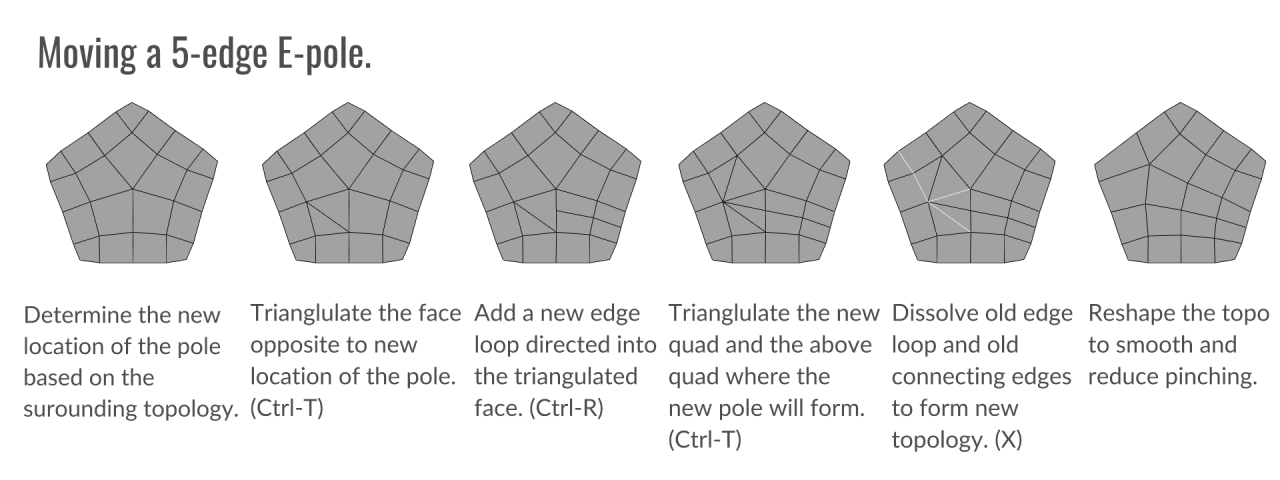
That's all! I hope this short primer on edge poles has given you a ameliorate agreement of how to apply them finer. If this guide was useful to you, and then please consider sharing it or contributing to the projection's Patreon page.
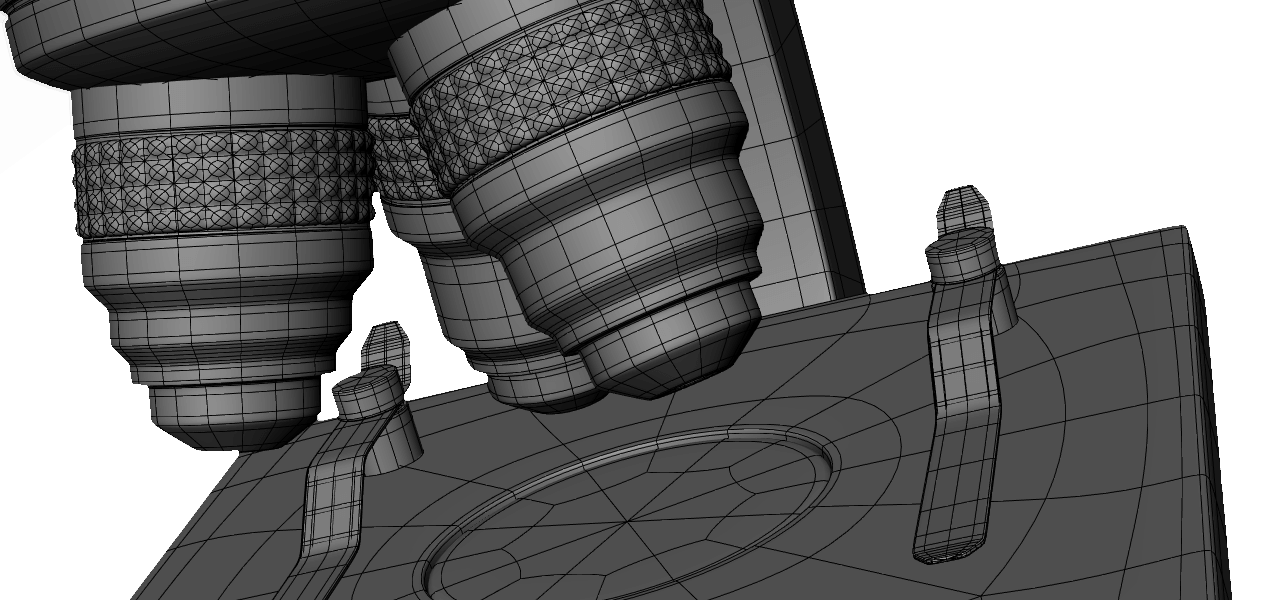
If you've ever tried to model a car or any other shiny object, yous know how hard it is to get perfect reflections outside of using CAD programs. It's tedious and well-nigh impossible to get 100% right.
With that in heed, I thought I'd talk most modeling specifically for these types of surfaces and the best ways to make it as painless as possible. Regularly used subdivision modeling methods rarely have the level of precision needed to make these kinds of surfaces, so I'll be covering how "hack" sub-d modeling to best utilize A-class surfacing ideals to the practical methods of subdivision modeling.ideals to the practical methods of subdivision modeling.
Evenly and Sparsely Place Loops
Even spacing, while often unavoidable without calculation useless edge loops, is a goal worth pursuing. Fifty-fifty spacing ensures curvatures stay correct by not introducing any irregular areas that might produce artifacts.
Considering of the way subdivision surfaces smooth and subdivide, even adding an extra border loop that "seems" to follow the surface of your model can cause infinitesimal distortions to reflections if placed incorrectly. This is why it'south best to keep the mesh equally minimal as possible, for as long as possible. Keeping the mesh simple so you tin can understand what your topology is doing.
Minimize High-Density Edge Poles
Edges poles are well known for creating mesh artifacts and distortions. But they are often unavoidable in sure areas without sacrificing another part of the model. That's why information technology's best to move poles to areas of less importance or curvature to make them less noticeable, rather than detrimentally removing them. Remove any unneeded poles if possible, but autumn dorsum to moving them if you can't remove them.
A big request has been for a mail covering moving poles, so I'll hopefully be working on a total guide covering this presently.
Make Curvature Contradictions Afterward Finalization
Curvature contradictions, meaning things like door handles on a auto, or buttons on a command panel tin can crusade major bug with topology and reflections. The chief problem is that these contradictions can nearly never be isolated without either large amounts of holding edges or creasing with very loftier mesh density.
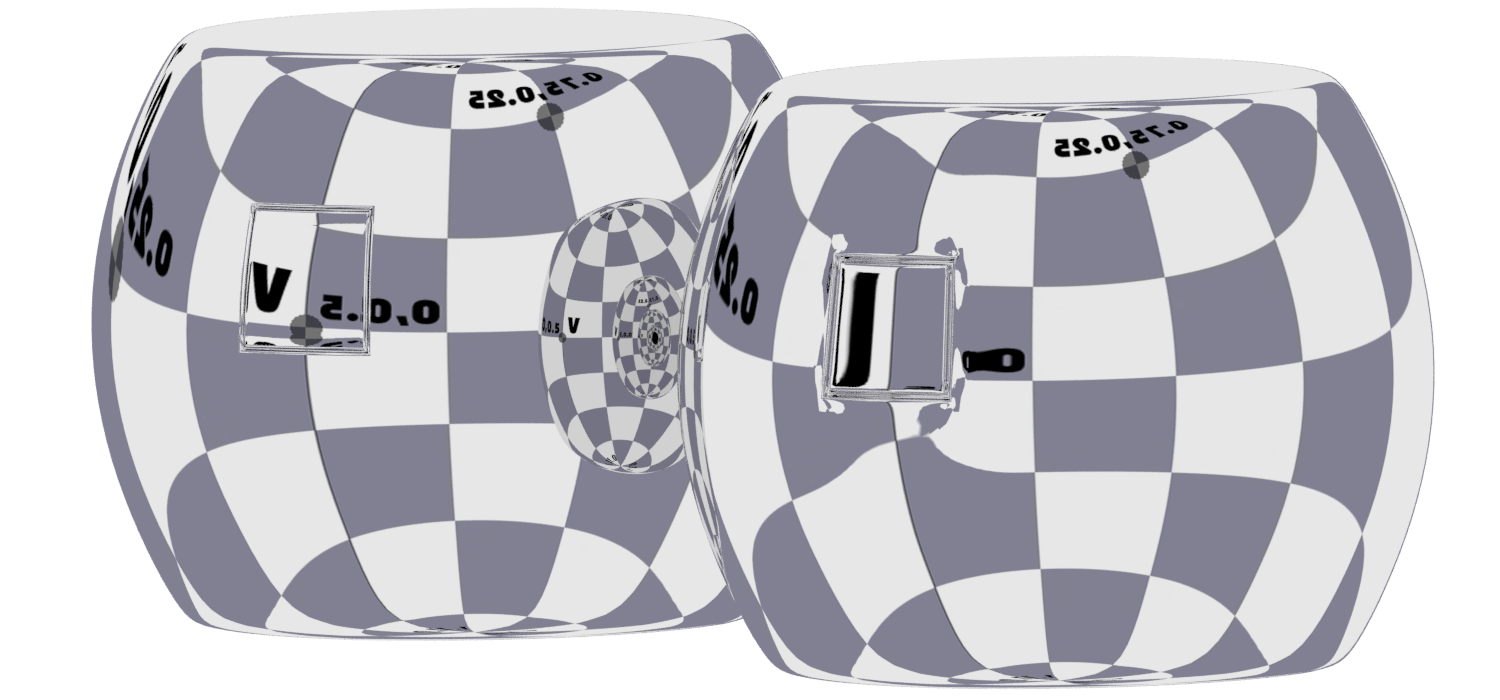 To solve this problem, it'southward all-time to add together contradictions after i or two levels of subsurface smoothing have been applied. This way, the curvature is finalized before it can be altered negatively past any additional edits.
To solve this problem, it'southward all-time to add together contradictions after i or two levels of subsurface smoothing have been applied. This way, the curvature is finalized before it can be altered negatively past any additional edits.
Don't employ Holding Edges when Possible
While holding edges are a bang-up thing, they almost always cause distortion on some part of a model by adding edges along the entire length of the area the loop runs. The alternative is to use creasing when possible.
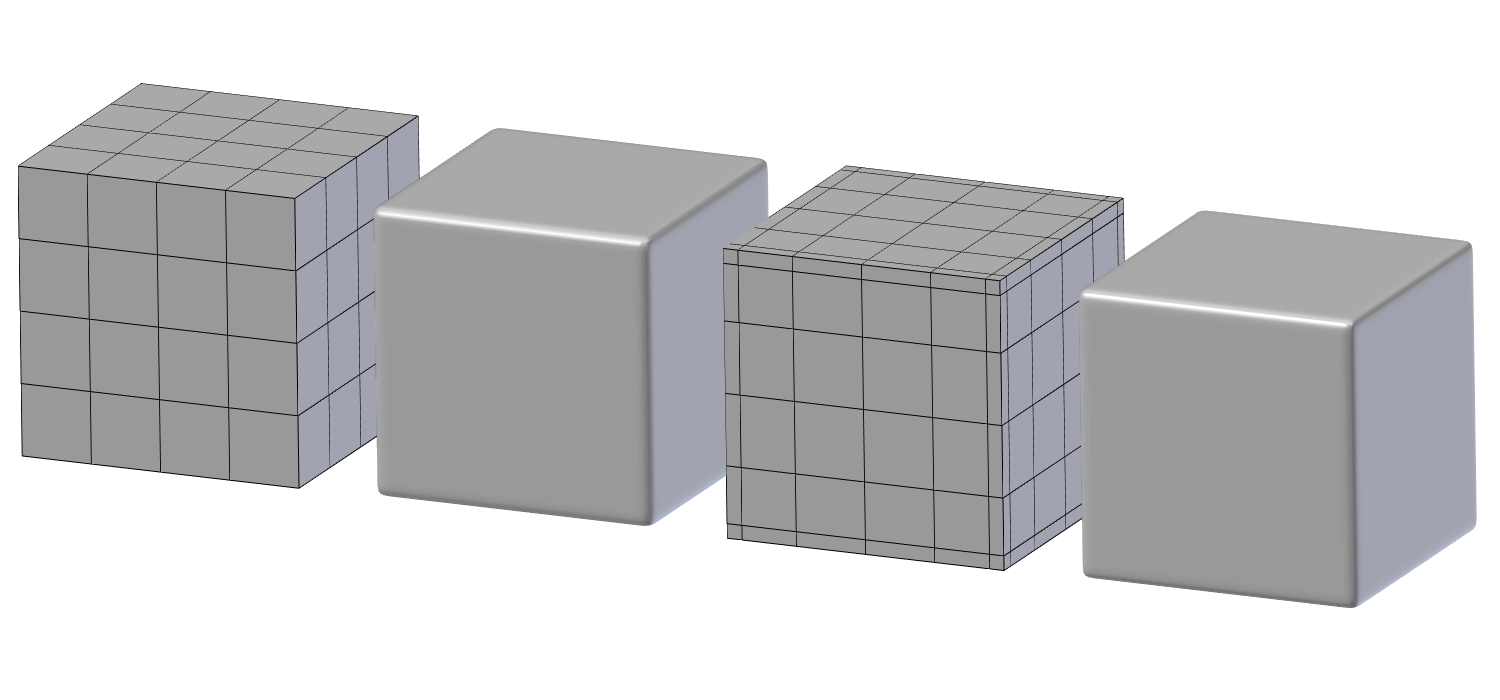 Creasing, especially at loftier subdivision levels has almost the same consequence as belongings edges and can create topology that is much cleaner and easier to manipulate because it uses the extra subdivision of sub-surf.
Creasing, especially at loftier subdivision levels has almost the same consequence as belongings edges and can create topology that is much cleaner and easier to manipulate because it uses the extra subdivision of sub-surf.
Non-Destructive Sub-Surface
Ane do good of non-subversive subdivision surfaces is that you tin can preview how the surfacing volition look without finalizing information technology. This is an invaluable benefit of sub-d modeling that other modeling methods often lack.
Previewing how subdivisions will affect your topology is vital to making certain there are no distortions in your mesh. Considering similar I've said before, you lot never really know how it will be transformed by sub-d smoothing.
Use loftier contrast Materials during Modeling
I of the main difficulties in creating perfect reflections is previewing those reflections within modeling apps. The default Matcaps congenital into 3d viewports are too low contrast to notice infinitesimal imperfections. That'southward why using loftier dissimilarity Matcaps or patterned reflection maps is a good thought for noticing things ane ordinarily wouldn't.
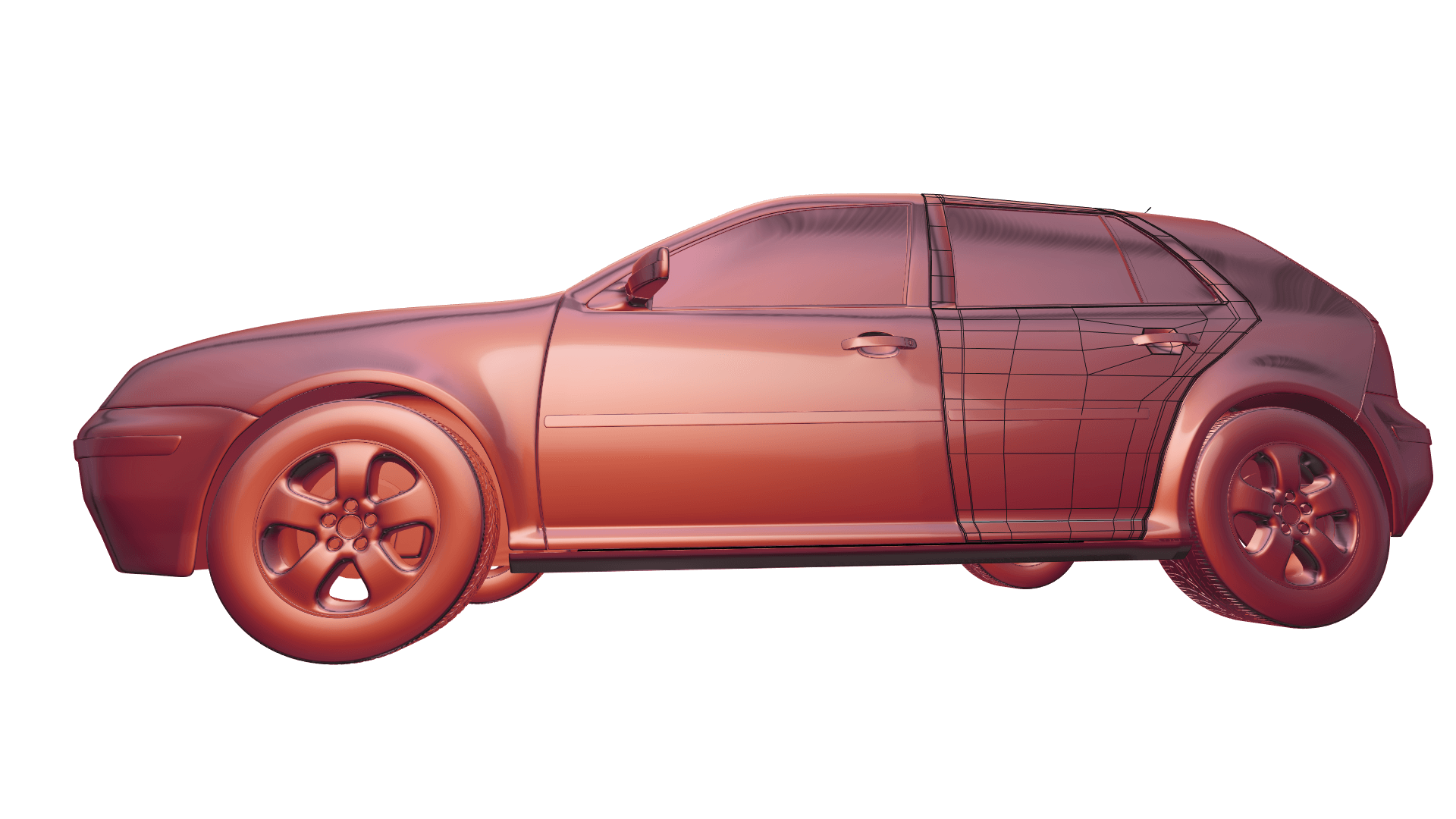 Depending on your software of choice, you might have a Matcap viewer available or some other way to change the viewport material. If all else fails, a fallback is to render a preview of your mesh with a checkered map set as your environment texture.
Depending on your software of choice, you might have a Matcap viewer available or some other way to change the viewport material. If all else fails, a fallback is to render a preview of your mesh with a checkered map set as your environment texture.
That'southward all! I promise this gave you some helpful tips for reducing mesh artifacts. Simply earlier I conclude, I want to thank CGcookie for graciously sponsoring this postal service. CGcookie has some fantastic modeling coursework that'due south defiantly worth checking for both beginners and advanced artists.
So if y'all're interested, check them out by clicking the imprint below. :)

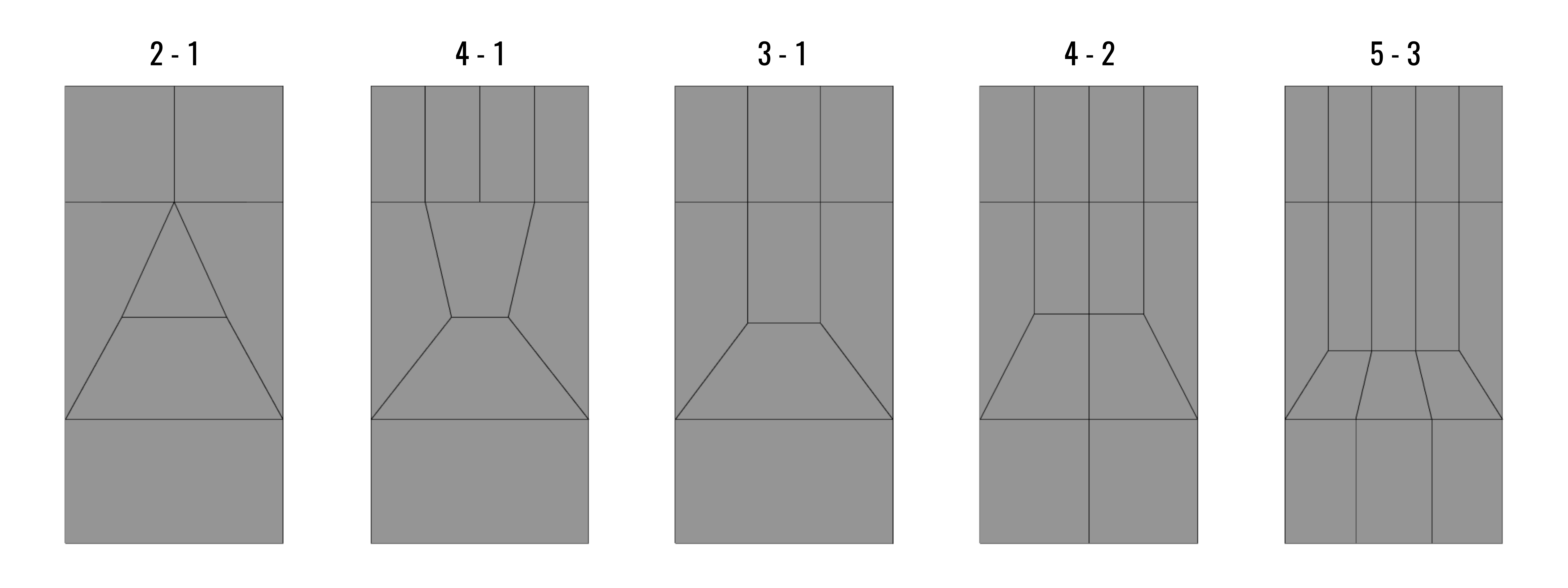
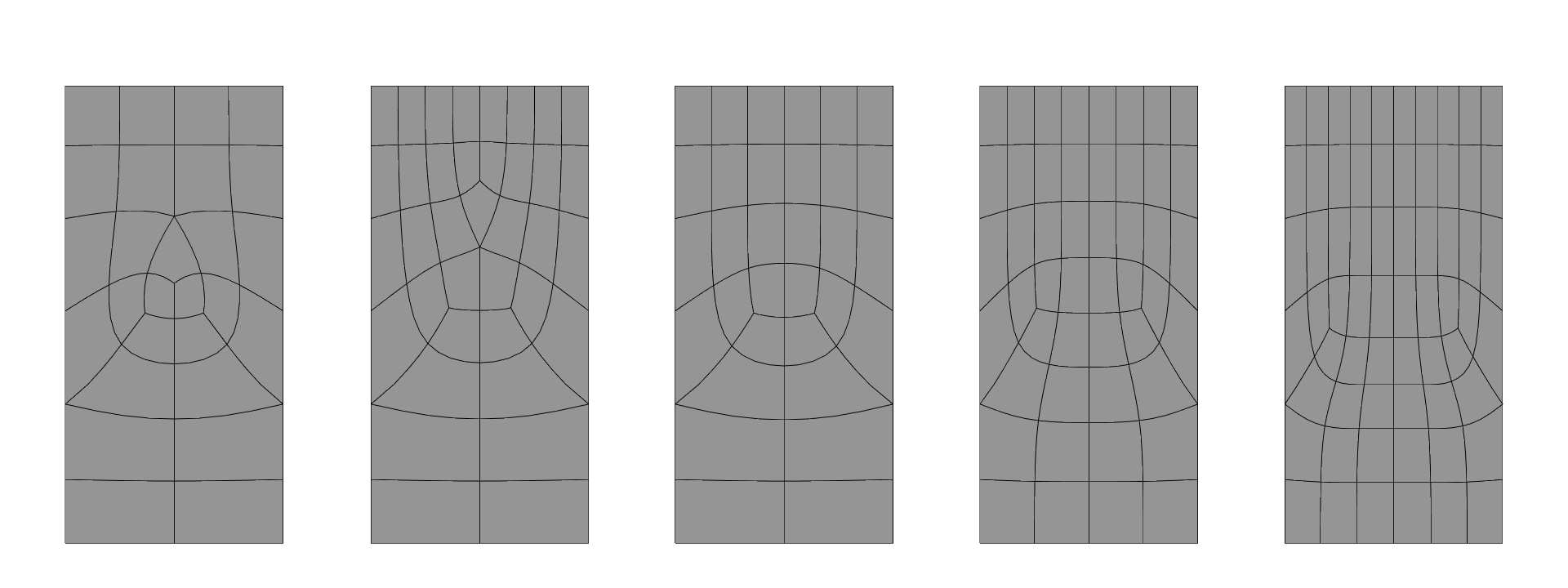
Subdivided Result
Optimal Border Loop Reduction Flows
An essential skill of modeling is knowing how to properly reduce the number of edge loops from a high mesh density to a low density. This involves some catchy topology. So let's accept a look at how to best reduce the diverse menstruation types.
2-ane and four-ane
The 2-1 and 4-ane flows are the trickiest to handle. Most methods involve substantial distortion of topology and/or the addition of more loops to the left or right of the intersection.
So, after experimenting with dissimilar forms, the results above seem to offer the to the lowest degree mesh distortion despite containing Tris and Due north-gons.
I apologize to any quad purists out there for the lack of quads. ;)
iii-one, 4-2, and 5-3
The iii of these flows are very standard flows that involve redirecting the border loops back towards their origin. This trick is very effective. and maintains near perfect topology in almost situations.
As you can see, the four-2 and 5-3 flows follow the form of the 3-ane catamenia. With the only differing gene beingness the number of heart loops. This shows just how adaptable this method of reduction can exist.
Hope this helps! if and then, exist certain to hit 1 of those share buttons beneath!
Also, if you're interested in supporting the content here on Topology Guides, delight consider making a pocket-sized donation to my Patreon page to help with the cosmos of new content!
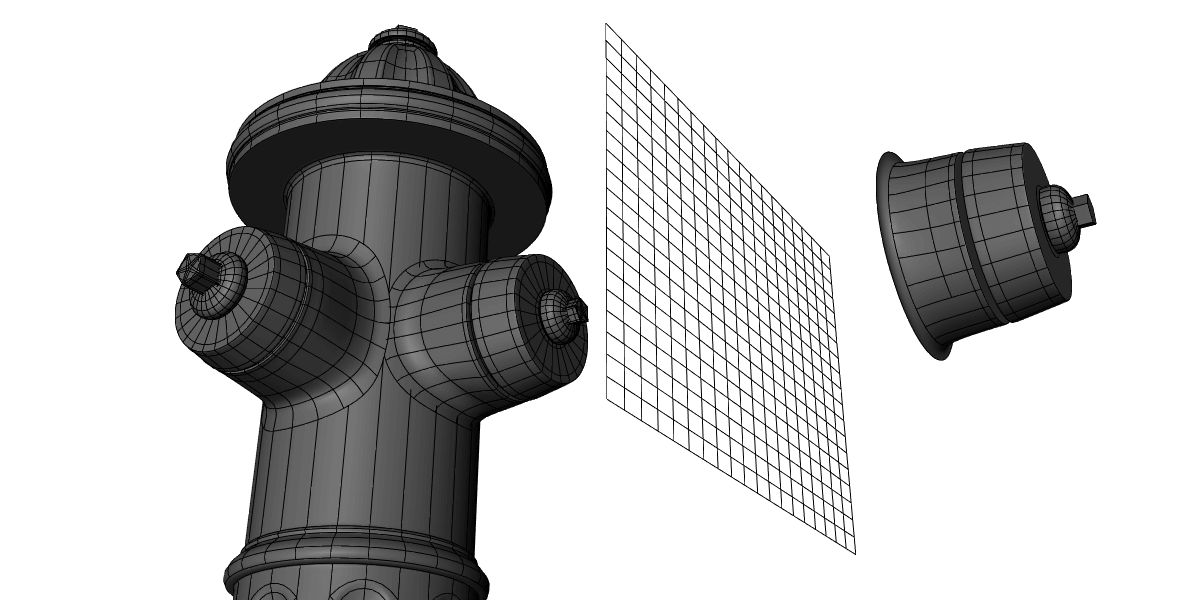
Creating Seamless Decal Meshes
I've talked quite a bit here on Topology Guides almost integrating shapes into meshes. Only until this point, I've overlooked a surprisingly adequate workaround to traditional modeling practices for integrating shapes onto a surface.
This workaround is the procedure of using "decal" meshes that hover over the surface of a primary mesh, yet seem to be fully integrated once shaded. The method I'm about to bear witness you works mainly for protruding convex parts of an object. Such as a door handle or a push on a workstation.
For this process, all yous need is the "decal" object you want to integrate, and the primary "surface" mesh.
Note: For smaller or concave decals, I highly recommend checking out DECALmachine. Information technology's a fantastic add-on that's been spreading like wildfire in the Blender customs the past few months.
Offset Elementary
In improver to the decal and surface nosotros're using, we'll also need a 2d lattice roughly in the shape of the bottom of the decal. Forth with that, be sure that the decal has a lesser rim with some type of bevel to make sure at that place's a smooth transmission betwixt the decal and surface in the later stages.

Once y'all have all these elements, lay them out in a similar way to the screenshot above before you lot move on to adding vertex groups.
Vertex Groups
We'll demand two vertex groups to become the decal working properly. One for the very outer rim of the decal, and some other for the larger area around the base of the decal.
We'll utilize these groups later for deforming the decal to the surface using a variety of methods for mesh deformation.
Using Lattices
Later laying out the lattice and decal over the surface, you can commencement to use the lattice to shape the decal.
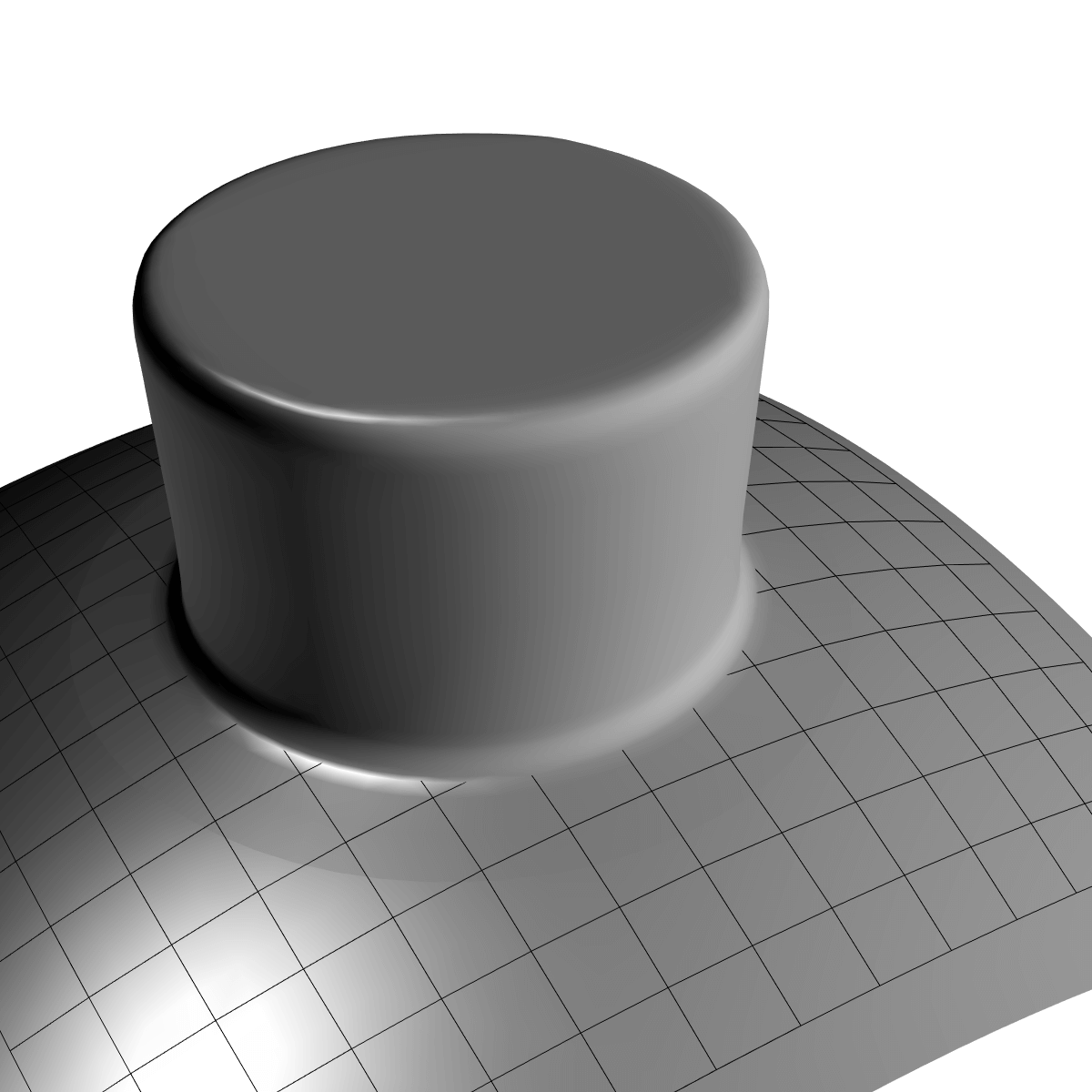
Start by applying the lattice to the decal using the lattice modifier. Now the lattice has full command over the decal, which isn't quite what we want, and then nosotros'll need to use the larger vertex group we created earlier to brand sure the lattice deforms but the bottom areas of the decal.
After the decal is joined to the lattice, apply a shrinkwrap modifier to the lattice with the surface as the target. This should give a crude version of the concluding effect. But don't quit even so, there'southward however a lot of perfecting to practice.
Perfecting the Shape
To perfect the surface, the outer rim still needs to be adapted. Otherwise, at certain low viewing angles, we tin sometimes nevertheless run across a slight gap between the two surfaces. Of course, if this gap isn't visible on any model you lot're using, then y'all can go skip this.
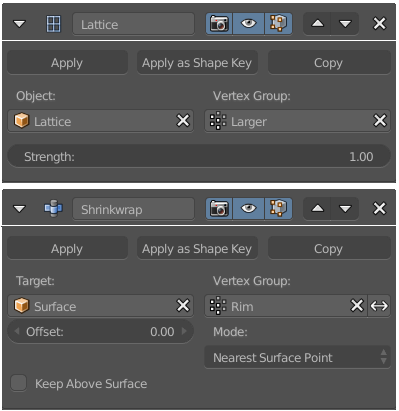
To adjust the rim, apply a shrinkwrap modifier to the decal with the surface every bit the target. Next, select the rim vertex group to make sure merely the rim is affected.
Correcting Normals
At this point, you should have an almost perfect mesh uniform to the target surface, apart from some shading artifacts. If not, come back to this step later and have a look at the troubleshooting tips below.
If information technology all looks good, all that's left is to apply some normal editing hacks to smoothen out the shading. Again, this is too a very picky detail and then you might exist able to get away with skipping it if you lot're non doing close-up renderings.
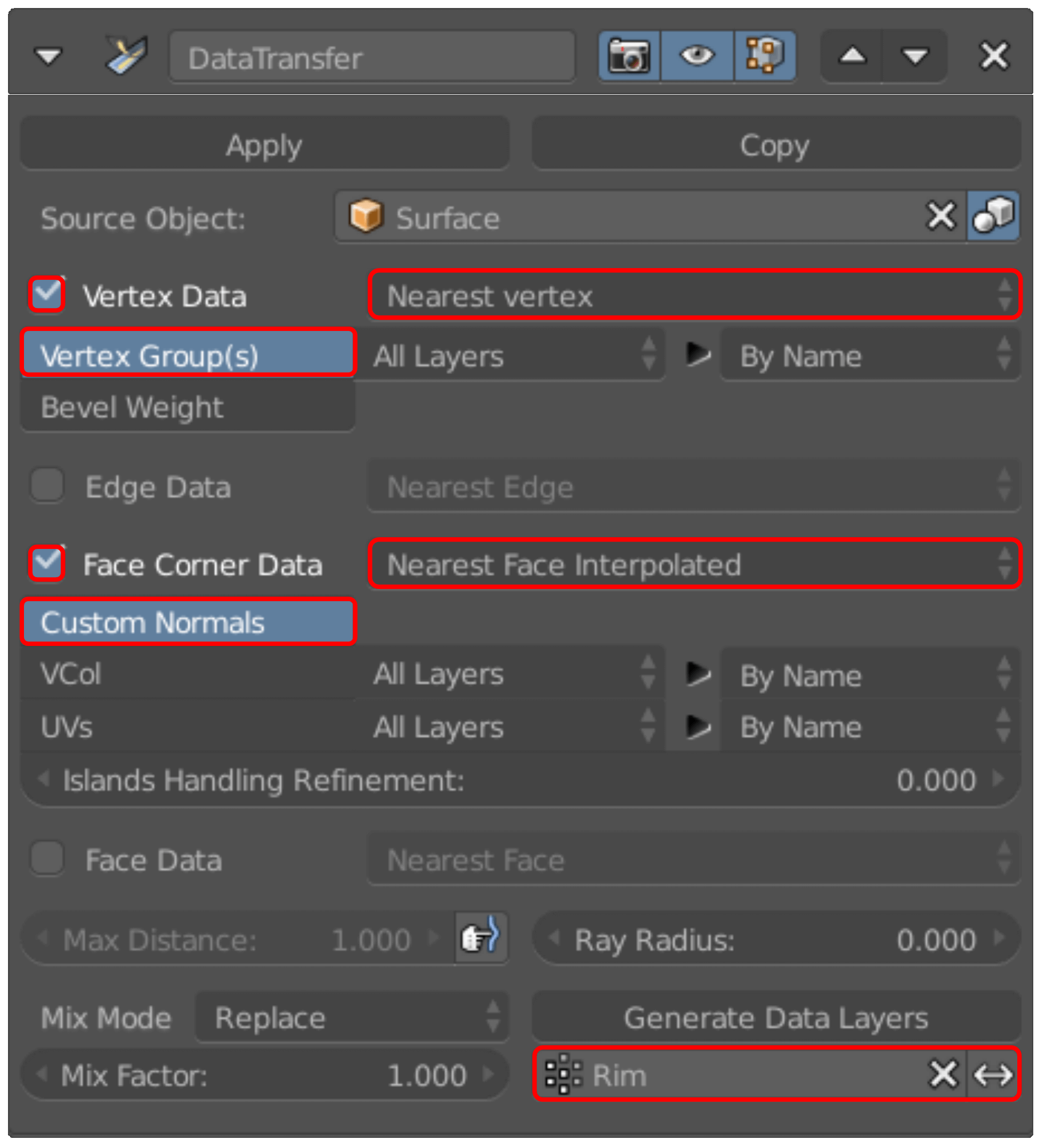
Start by adding a Data Transfer modifier with the surface as the target. And so you tin can set the settings equally shown in the screenshot and click Generate Information Layers nearly the bottom of the modifier.
To briefly explain what's going on here, the data transfer modifier can copy the normal data from the surface model and use it to the decal. Which makes the Return Engine (or viewport) view the two models as a seamless surface. Of course, this only works if the 2 meshes are approximately in the same location, hence the need for the previous steps in this guide.
Troubleshooting
If everything went smoothly, great! If not, don't worry, here are some tips that might help.
Origin Points
Having the origin points of the lattice and decal in the same spot is best when possible. Otherwise, sometimes the decal will non deform with the lattice correctly.
Applying Transforms
Make certain to apply the scale of all objects using CTRL-A.
Setting the Rim Shrinkwrap
If you notice a shadow under the decal, information technology'southward most likely considering there's all the same a small gap between the surfaces. Adjusting the offset of the shrinkwrap can often solve it. This applies to intercepting pieces besides.
Tweak Data Transfer
If you're having issues with the edge of the decal shading properly, try tweaking the settings of the Data Transfer modifier. Often times its normals that cause seemingly unsolvable problems. Don't overlook them.
Still having Problems?
If you're still having bug, I've uploaded an case file herethat has all the settings and modifiers laid out. So if all else fails, you can consult the file for help. ;)
That's it! I promise this guide was useful. If information technology was, please consider making a small-scale per-postal service donation to my Patreon page to support my work here on Topology Guides. I'd actually appreciate it. :)
Happy Modeling!
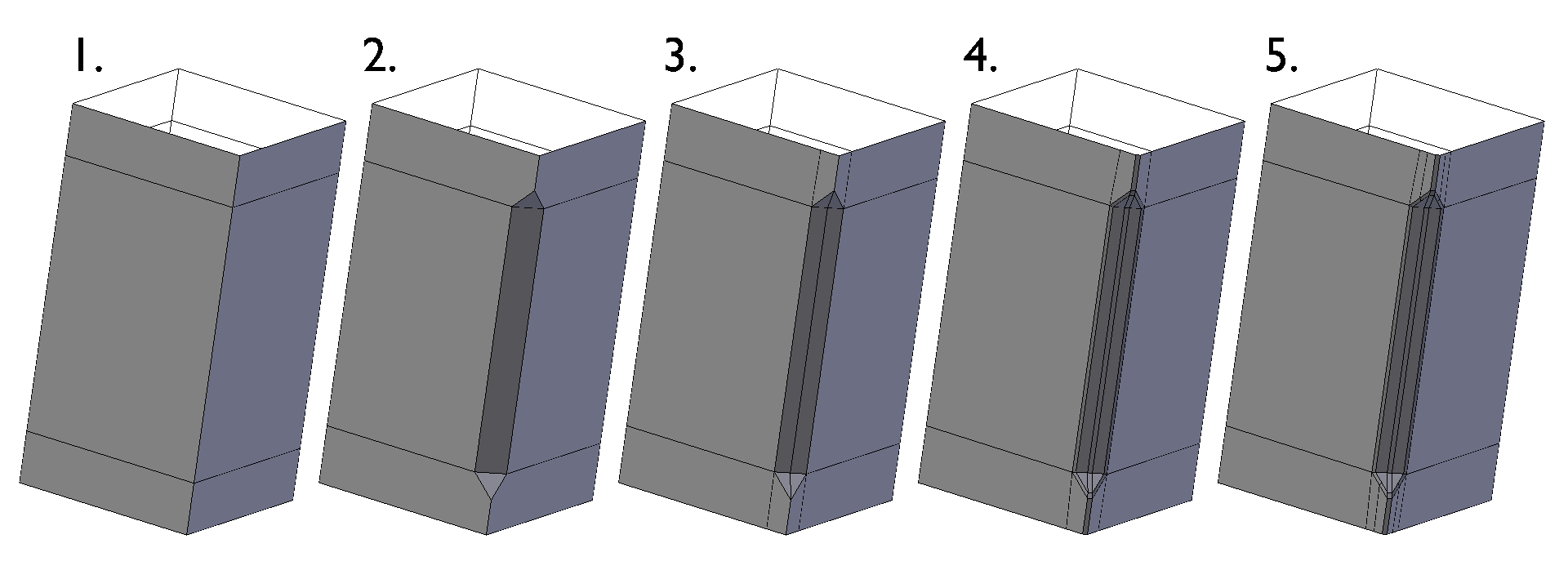
Creating Chamfered Cuts on Corners
Today I'm going to be showing how to model what I called a chamfered cut, meaning a chamferd section of an edge, often found on difficult-surface metal parts.
And then without farther introduction, permit's get to information technology.
one.
Kickoff off with calculation two edge loops to define the area that you want to chamfer.
ii.
Next, bevel the edge created by adding the two border loops to create the basic chamfered shape.
3.
Connect the 2 points of the triangles near the corners of the shape to make an edge loop downwards the center of the chamfered area. Also, connect the other ii points of the triangles down to remove the n-gons from the model.
four.
Bevel the outer corners of the chamfered expanse a pocket-sized amount to make sure the edges are held if subdivisions are applied.
5.
Add more than holding edges to the outside to keep the shape contained, then add sub-surf if desired.
That's it!
This time I'chiliad going to show how to model a chamfered circle. I spent a off-white chip of time on this one, trying to find a uncomplicated method for modeling the shape, and I recall I found the simplest one. It's non ideal (a few ngons), merely the other methods I've found to be overly circuitous with also little payoff. Permit me know if you accept an even better method because I'd love to run into information technology. 🙂

1.
Brainstorm by creating a circumvolve with a low edge count, in order to requite a chamfered look. And then add a loop betwixt each edge for the side by side step.
two.
Next, pull the center meridian vertices up in society to brainstorm creating a rounded top.
3.
Now bevel the heart loop to complete the rounded look. Experience free to utilise as many segments as needed. Next, add a new circle in a higher place the mesh with the same edges count every bit the loops of the main mesh.
4.
The ii loops tin now be bridged past using the "bridge edge loops" tool in the edges menu (CTRL+E)
v.
Adjacent, select the corners of the chamfered section and bevel them. Be sure not to bevel the top edges, and then that the circular acme maintains its shape.
six.
The concluding footstep is to add holding edges to all the sharp corners and add sub-surf as desired.
That's it! See you lot in the side by side guide!
This shape is pretty simple. but a useful one if your modeling mechanical or sci-fi things with grips or ridges. So let'south go to information technology!
1.
Showtime by modeling the curved edge you need to incorporate the ridges into. I recommend modeling separate to your main model so that you tin can tile it later and then add together it back in.
2.
Add two loops to define the inset and outset parts. If you want the inset and outset ridges to exist the aforementioned width, then brand certain the centre section is the aforementioned width as the two outer sections combined.
3.
Cut out the area y'all'd like to be inset.
4.
Add a quad to the commencement four vertices forth what volition exist the wall of the inset. Make sure to model this quad to be properly aligned how yous
like it, every bit the residual of the inset will exist based upon this quad.
5.
Fill up in the residual of the inset using the fill up tool (F key), or using the F2 improver for Blender to arrive even quicker.
six.
Add belongings edges or mean creases to concur the shape, and then utilize sub-surf. At this point, you tin easily tile the ridges using an array and reintegrate information technology into your mesh.
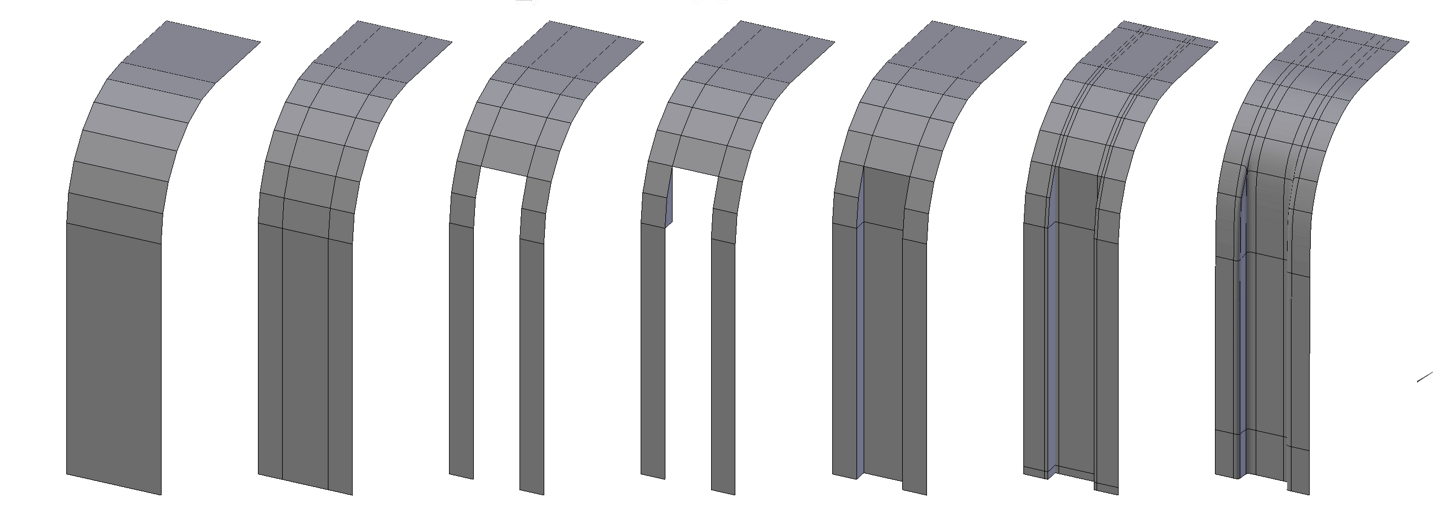 Encounter the final result on Sketchfab:
Encounter the final result on Sketchfab:
Source: https://topologyguides.com/
Posted by: sanchesaborecturs1970.blogspot.com


0 Response to "How To Clean Up Bad Topology Blender"
Post a Comment